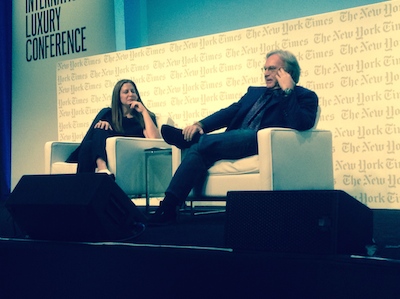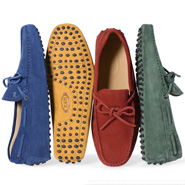MIAMI – Philanthropic efforts have been enacted by many brands worldwide, but when it comes to efforts in Italy, the home country of many luxury houses, internal philanthropic works are sparse, according to an executive from Tod’s at The New York Times International Luxury Conference Dec. 3.
Luxury brands typically hold strong influences in their home cities and countries and can therefore present themselves as chief contenders to lead social change through philanthropy. Reaching out to foundations, historical landmarks and people in need can create a positive aura around a brand and help the brands connect with their roots and impact local communities.
“Well I tell you about my personal point of view, we are Italian, we live in the country that everyone knows about the culture, monuments, good style of life, good quality of life,” said Diego Della Valle, chairman and CEO of Tod’s S.p.A. “We need today, especially today, to give a strong sign for our Italians and others that we are ready to support the work of Italians.”
Cultivating at home
Tod’s has been well established in Italy for many years, so when the brand made the decision to help restore the Coliseum, one of the most iconic monuments in the country, it was a logical philanthropic move within the country.
Giving back to the consumer may not necessarily be a direct brand-to-consumer connection, but supporting local cultures is indirectly supporting local economies. These actions are logical for luxury brands because fashion is so often determined by the culture in which it originated.

Diego Della Valle at INYT Conference
“The idea is as it is possible to do for Italian people like me who are visible, lucky and in the position for our country, especially to ask back nothing,” Mr. Valle said. “We are here for our country and we need to do many thing for the country and it is important.”
Stepping out to fund a project, like the Coliseum restoration, without any direct branding or marketing benefits, in a way, creates its own marketing campaign for Tod’s. The group was not setting out to have their name on the Coliseum; they genuinely wanted to help their own national monument.
Mr. Valle’s hope with the Coliseum was to spark a revolution among other Italian luxury brands to step out and help their home country. With the political and social unrest, and the rising number of unemployed individuals, helping the Coliseum may not be creating jobs or feeding those in need, but it is cultivating the country’s roots and looking to preserve Italy’s heritage. In the future, this may help create jobs as more and more people visit Italy to see the monument and experience the culture.
One at a time
Tod’s presence with the Coliseum included financial backing and control of timing, otherwise the government and team of restoration experts are leading the project. Since the start, other Italian brands have turned to other famous landmarks to help restore the country’s culture.
For instance, Italian fashion house Fendi is the sole benefactor of the project to restore the Trevi Fountain and the Four Fountains in Rome.
The “Fendi for Fountains” initiative allows the brand to reinforce its Roman heritage by giving back to the city that has supplied inspiration to the label over the years. Due to the foot traffic at the Trevi Fountain, the brand will likely see a rise in brand awareness from tourists (see story).
Also, Italy’s Bulgari is investing in Italian heritage projects as a way to give back, while also celebrating its 130th anniversary, with a $2 million pledge to restore Rome’s Spanish Steps over a two-year period.
The project, slated to begin in 2015, will work to restore the iconic Italian landmark after Italian prime minister Matteo Renzi asked for private investors to help maintain monuments throughout the country. With Bulgari behind the restoration, the project will likely leave an impression on travelers who visit the Spanish Steps (see story).
Brands who have the resources and are profitable tend to have some philanthropic project, but choosing a project that is close to the brand’s DNA can resonate deeper within the company and its consumers.
“Now it is important that the success model that it is better to take time to do things for the others,” Mr. Valle said.
Final Take
Nancy Buckley, editorial assistant on Luxury Daily, New York
{"ct":"kOzG5ORFaoonE6aMmNGWPiZOBlf4QrqWrjwlK5asZ8yojoPbhzbGbfzYsDAWz6wcQ3dgd6No2YpnoD2Y39hIrRWSeE7px1QgIpF3geq3Avq9nHMTNx+U32Fe66H1eioK0ikMGIha\/vMMUADym+OeWSMkFAD5IU68kIuY34mdnV9JDgh8WOFDPBgBQ9OPiigPajw8Jws01bpr0QoDO6z5mS4pA3A4wphipw1W4JFyouM7A44EuRIB57IsVI074+0O6eIPwe\/dtCOJ63eODZUxxe8HppeE2qFHfbNq3\/oIgxb9jzpKIyrNk\/RRrhXV3CE\/AfFn6Gpb2rDLbL\/rofGqkczJ24ROZjECGwCQsSM9a0RfWtQy3CwaRzWL6Tb5Yd5BN1mGA9zR1\/llzAz8XlBnpXQZxnh\/ObXbNYqC3GOwjADZlkhV3EdcfQ5vxHvpZizrJx2BIea9y+tuAFrPOh3K1GqSdhDG0eLV6W8Jjg13rqdmCnB03gjjd0N4YC98Lop0OWX0h9AMK9GFRtJIPAumbevlFxKcc9WjxdMJngfY489ocdlAHKVaA2RqTnQpnKwGBCNFK9hYcX19ZMZT3mr7rJYvNPIpUj93\/BncnZI0a3c\/0xUyq\/DIuDYKy5pNHShCv8p8tFpWYOifTEvGh2sw3KQF6xyvQUc4AtgRlhMY0LADxrSkG4ced1sd2zkJNGM1bXabETkUsIG8la9pCYGi2qKIcF2D0IgKHuZ0zSgGa\/eQZGN\/v2VvGvx1KwGg0s3t6ifnjhhGIZkCZ\/vuMCAzF\/UjsfU7kwLz\/TgHR2gnQJfoLRupa0nJmheAbwOVhJcnk0a+zXTG\/D7T5D\/P\/8TLRZmqGtubMhegbaxv2Uzud\/cMw\/EQnwcP8sIm3RuToWwu+nwwK+g7t+K4\/X7jf6i4PZ\/1TVbCzKzw4+zgiLnpwGjDQbksCEVt+TRF5M42ZCl4Wo2JjgjjeMvzkEmfBrjupWxz3oVxUK0ASN8yPsU6QRMGay08s30UPR\/PXzDkWPzdF8+TXznRG3UYd2ByRDWzicwvMZLES6nwJQ1Qvk0jHIFJFX6aCfH7gH3OVq1C4N8WenSG67Ab9tyqsAvCUqIGaT5Q5SVi4fQuhAD62N+CLKWkRAPfkWLcb0wxQ41ZqCJkF1yAoINmb9Lw7u43JfIQ20lX3Io+3zZm8lEi2E09ZEO5vY9QMkgifqeHjKHUD39l0gcIQ8StKLyeDXlxqZeWQzxMFNwG4xa3+OTMPjJf7+vdY88ya823p2JjrVwLKznJOWLpqq8QeM+13KT6PBBO1eXcw1RWCRGoEg50RCgqGfNYvM+jHaQyIhk39hytkGeILjtueqMesy\/8N8Fs1MgfMt0ysISxGgPEBn410OBaEKvSJ4Z7gG9UuhZJ2xNEhAoFnZ+y9eKSiyuTcOjXuDm0QJ3VQGA3lnkhbjrldFkQPgGuX13CJskWwTM37kEMVKmtnqwsSP1Yb863Yng+5kJH9CKs5L7j3CQudCnwL\/nH\/BY0ix4RjacD9LGgsenYN\/yo5HGZwPoyg4yVa01iLCKlDMQaw+aRY\/3SgwBFK+SOckomstfy5L9SzllC10h6+vL91EFUK1XamfixKeHWKVzOIjGAWwIIUc0v9zRis5LFWWBRgtvp7JszHqF0MtYH1BGlr8oI7fFL8DBjG6gHJwyZylOUHyhjHPv9oW7XuMSndyAoLn0tOjAWIKF2w+kKEq2pDI0es+ydC2\/OwLt9mM9sX\/0dj86sByQAa+EkYbSZlEzV\/zKiThjbS95TU7HFErmZTfAzrMP5GvotAJv55WaIpavf3UnFxVProsygqqRA8TUeJZAjVXx+dAlj75rHHSKsqgjCZ605YVU4bz11tp\/f8L4hmiC1Br4lIIXFoMurhUVhrwJEkYYoPp7lMOFFugTHZS95m15yDaJFWfIChxi6h6J4Jyz1+p0vRviMVSGrQrfHZJMqi5lyWo+1SXxUoMyQ8lWLyFJ47Df3i+IJ03q6azTKmVTvRThJWcXEGDpZm4kTK1WgAjPu8oOM7EmBpDGvRaTMM85ns5VUhgkXDQqOExRugckzh79UfCeJhaiudl5eg+cWsCcVuaG+JZPumfFZEdJH8JOL4umXCcRI4J4xNBvl1lxf\/\/0CjlYvJ0Uc6scE0yt+l9iCwZoBNHkbk1JaiOt9f6TIH0vyxCQErOo\/a0wn1fnGZn2mIdTebPHEsZFbm6I5UtWxsgIXwee2iCTb6xAhDyZjqAGbbwpAl7ozUgVgUIC3Q\/Z9PnhKRTIUgrjoklI68ZOjmlrMO2HH5nk7wTZL4zG71iz4zBvdccwIvNYk2AcOVvGIPUshGYNnhGoWkRbmTDfzRB+\/Mzg9zrGBr3vWz5bUxFyAbEFHgaKbPkCgT82YPc9hmv5nx5AT8GeDJYZ0H+Snm1JpK2FoKmoxYbcYTI5o7guutJKqDnZTMV3dYlGrtjkkWVyglKf5HVR0a3Vq+zj3Xg8Cs10\/ajECvEvydjQ56suoB5JkgLJMYd8jSvwjxHauo3MMvaj6eSTNNY\/MNJe1ccQeccKNobqfRRHToEdtlhwSrzhwL\/MIwbdgVAJror+tI+plk8Cu1KDahWmxcqGZFUmkJsYe4OCkO8BMQ9s9YSEilOtZwmbAUHElgWK1DOIcIRLUkhgqNqDfRVRAfWTUi7XSlGm79924Tj0cs+3C1IW9lkltvnK3OlqDvCLRiidZ+Lvx19OmBvP4v5duGdugL+FuXowCc0INkijoRgiN8WKLov5qOnCWUXtF8GKMQrUBXOW691lbGhQ09zL1LnehNecK1CF6V1z1vgpODnzYDdGjdWdIhK1RapoitkGE5kwDNzAQV0AJwLc\/IaOzo4AM\/cXF0mes4zz2SltfDEYIeBcM9EsMSUaqsaaMO+tAxPbaZlkC+R5ydxRWlPdNa9ezZAyUMduxPzTyCe61gjgAF0i6k\/RqmN+RSJA4Q7y1FprBzwWCnh9eviDxVWJmTToYgvxvUBYVcaOBQ1L0RiF7csc48OasRCFxsnnwYhXzRTBykDBZ\/UmGMe9+nidqJyUybTlYnPxXGTE9ybtY0hFfVT1PJzq1nIlBp33G5OVxg8Afjf6kvQxyGYm4\/2seKdyXqGJNLC\/y8YwmVf4lFa5E+ZRzAteIihZm40w+pjUNFGtKVTJGscdwAW6PEERfug+KTpsd+lTPr7Q4HZU6wNl5KtglHX4yy1nTwvBGt0IFXKmB7AHX3LnAT7nFPQ0zq8vHEGM+5YX7hibLW9cQc0HW5Pn415Anj8j2KtpKbsbTYgh5yoMnJWjKvWnw5kFc8Wd6p803AqwqszauT8zhdUZ2vqiHxJNCoyf3j75urtiafwEXSIU42fb5Q0w7FAn8mKk9P9DZvqph1mFL277QqFsEEG+u\/YmIG77a95Il8T3IWizJnLWKl3clG+g9VcRjGN2bimsJo22\/lML0c91R4dTpBrxWlItSVpj\/8VbPWqE4kwxtl9lh2XMkzhKAfm\/KC570qKkit7tP7pu6lQc\/P9N1AgucGRATaJ+s2S+Roh9cYwLzlf\/BOKMl6t9iUGUJAQwl6DUbg7dMvkGjRGNexOrd0s+6eRfMbMzY8y+uTTFhTY4sPrywo24iuOZuZsfOOGoMjY1sMa0wYF6bpukwnVOX2GGxsViGCelw56G3\/A\/QySJFLV2LkxW3RVlTKkLaMoTEsod1FhxguE37GsEETYkmVDtEb3lbOeWcL26ciPXze0y+YXq7P2T5jkKji8fKxjRTDNRNq9Ie0kB5l1F6FdwqjdJyGb1hFG2ZcTKIKoo0aUQ77r1k7fPNxniUO1CBgdFLSGy0D2lZBxTvrqdvVtUHa4Oz6ZoBcYrOAGNV20Y5zJkaoYkM9PoxMCO2yWm9yaQRbg0EnF2kWW1ilk35wbqHsXQeH89wkreK1CtrCkZi3qyjpiXgmmdM0Se2F3TC2itasIC\/iRNvQvtqRddM0yenB8sqY\/vKe4GKRFj\/sFat3H6sJswZArcV+azN5M0yyz1BMCaimli5cTqOGhpHMEeoZhisUCbwYXTNuChERmgyRYsK\/upCrOtwRNWYw9lbQ8V249gMLj+v\/iC1QbG8W7ITt02xvDyLFOQdMB2tGGR0\/C2QyhVpLEgJ8H320GBaC4uDueOzO1gnjxLQIKXbCs7EGrnu+bqKKcHXWZ0jhAgJjjVkleIilxN\/VIs20OpcFMNRycYX0wdTO1C0BuvE\/2XMQHTMSf4ewvS\/2vftFCVnri66Ea\/j\/lTBbcWVkBcvxC9z3uSErs9\/8BtfMF29WAwJI1ipOi8bEjXi9kz8xqCSXN73LziIzE4yC17AnfGbKHvCjgAJ+3iWO8PEF87BD1RrsD6t35aLCntT1bN8egIcVX62s+eE9Rt2O2LupEbyeRxp7lWmV72uI\/OCACurM9XTWD50J1xVXAlrAY7oebBiQ8edVbdGSqEk75tjCXTWnUp11rm2Yky3i0+ZI3lj1ZAHmVL3O1456Uo31lc7N117Q5Fef7jsVLudvul2hC30gWIupOSoqz9VOkRjRqfoSu3pwFWav7o+UVyRmeIjDvdOrfRPz8qAA3DVc5+haUJcXMGTkCbUqBIUmKiQS1nkIPIaS6LpkiMjDHSXa7bEXCTZ9xIp7WiksQYb+DjMiBnNnAW\/V+YYKO5D48qA+kucQAdljagGfpgR78bJWz+gyMH5hTHSLdOkSAkTVN+lSrTNz3nWUpqcG\/5CW3eWmRLvVf3KnhA7gnzMlVppKof\/HAwKBRA4FcuU\/JM8GbiTbVJ2VNMg8MGCEUXI1RIIq14e2vxZujUV0zW+Go\/czlQxZ\/TVEOKE73Vs7NBC2Fnds8YHdjlutBRJDzYfVaS0JJ8iFsnNOn1I\/rFQkjoRvZyHzYRzD6PTYLbSovUkcj2esSUL+ekJTQLJDK+63dQ8gAPoz3\/038RH7BZi9EetG+Zirsh59PlNFZFXq+oZi7+1rC76v34p+HbmdP4LSS5Jt3uGxhh1NQxiQqvAofsvGHq3GVpdyr42cq0SrFT9O6PNDuwBfH2VO4akXS2pfXK\/OJTH5La3pDo96P7jSWJuDOafepZc8nxqJfe8282YZl7m+8y14xIVhsURJ6fMX9IssPv33uQu4A5iLSUJHJ6NaX5amk4hBGiyBlcDEHImoRPNaGNv\/WiUrvZOOATlLI333JynejdUkVhyHQelPds4hFfWUUj3A0UO\/Z8DhxNYtRUVF7F5A85ZZc6RrhaZHihudXoA1a07onVHf5q1RE4nboI2ATRKEEuh\/PETfo7E\/Obx4ihS8C5ljKNMamLMQs8U3mBSt2TKYDPTqb6AbdzAq8cSFJZtDuxiZWJ2SJxCgIHRibRYF2CtGekxh7fC9o7gokddZ+4nxD6IGt9bkwxkKWOhYotYi9ECne9sgyCE\/yXYnSBhQFGHrmDRZzJrfJOrKxnAlI5NhydqsdNlvU7s\/IpYWxAkzTNRajlM+OsVS8FAHPK71c6jFUVoI22ndTxWNBGs9ed6GgoBLizxXff+Gnu6BzKr0XsGWtOqdVi2+c\/D77peFJftCBjUi8Ccvy9\/BJoAkO1Lcrg4Yz8RuCyC8kNs0Z3MMsjr6KgBiETs6osIHO8GiTWGx0f9Lsmqi4zKeAclCoBF+SVgyJeeA5JY8TljI9kcMkNCi+T8OzgT\/C2shB8AF1UkMgo+k4uptCYNnInl85RsW3XcmWfkxltHCrO2yvk3pT5rkuylXBS5t3Se7\/XNZzbjmbEACnTWPN8QR0Bzw+k0xY371OzoaOLahWxK9DHLlgRHgDEPq4Q+Ug\/nZR5J\/PByGyGXW\/4sQubOvqH\/mXbmgKitbX1EVGf0gJ0CuFsz\/sT8SfypvQnUDKldboxeaTr2P7Cq4l1dhPV8dfq+qXJVh5sm70+8E0VhnOx38z2D\/lD4tXqQDiKJGgxqiLQkt1v6RPR9uIf2GgdINASer6Et9PpskQPkjqaodYTAXwcG4CIqRvJke9h\/GeQN7Wret7JTg+gaQx1+JXvnkcHM9pdaQIeb194dnXPYjQcIJHwvF0Uz4NjAWoBs0AZneJAiehPQBMqMfFCLR78oS1mU9dgMUrDu6QrYNek6n4lGEUoAH783+RjCtMio2aTHp+4+GLWk3kOUfC6G8k8bowwKUV\/MrZimUunpPvDa6krWPbQ+6e0OQdEtrEu6G+UYHnx9tfF4TE3sYszpyNsrqsEwtf6qvUqoVy8GZRnjIylo8GgF34lDJ\/plZ8LE\/ejSmUqIiJ2wAZxqlaIX\/dXedBDekeGTNG\/ND0\/\/AwI9Q+78tO\/nQkItGlMIGIu+iyL+k6k3FAxX1piJcM\/V\/fAIt+MYARBEic8Q+FTjoWYHvsf1dJxD5VYsVpEOa+KMygOLZJ3GT1jywMgP2kuDT5wg89BLaIpy\/5gyInMMzaKqkypIIEo7s7ZdoRh7upW73UtwmvTjn6Xy1YYOpEc7xXgc6m3VhxwMTckQ0WVZexYhMN4oROrC4t9yiAkvbXoUFvsp1hfh+3W\/j7erCjtJ9D7D2pPIyM+W3s9CsKdU0g8p2ajYeBeWytvZgZU9+ZdYVUHn4x5RcXBu5HQV\/kkwr2Dyvj\/e1sXHvrynWC6Fp+SNnlQYbLhGVsDeukm\/nc8h54miIaH0d3aGykHZ6W68SyCvRvthFkXBr\/KKI+5mGemKaiFRed9BpcznoldWfpFT2Ec7nD3mY9gNzpwIgt693TDvcQF298NHIpjO2\/VPt+x3js9bCKizjGudtMrYgoAp+wat9WwJriDtXJEzlY8zH9RgccnwVSYvZ5E9FwWiiYHuQ4HbPFdKQTll+Rs2wpN4NYB1J0AP9cayMGjT2doZz47SoIKVjxgdqC5SSn+f6uMBQ4\/Ywfd7aP7JZ0Ydh2m5IFhXDTUHmHBU2iIkXwQRNyKy2XHgLaNL47Msh3xHsR4djaK6Bwn24ydFg02Y1ZbZ6W8y5SXfQ\/Ab3vF\/w6v\/mkyG3wABxlbYy0NcI1apqdD9L8uXszL\/tUGNXvqGoLW79arKg\/IynyxB6RnHd41u0je80T8YNVPH6qEbdwmnqkbOrMoV9DlGWShqfWs5S4xN8zLGqte7Y8IzjAvf1f7BiSDGb8KtgSdSkBIDkxhwxcS8FPfzsaPBFHOyy\/RJqPo1\/uZmLteFf6FVsiIC9JoVhdsIywcDtjr4Vqtcd8zC1ZcvV\/HcpoT2zkVZSj9\/4xDS67w4TdPxkR3Tz4DEyDkAdvNK19SzoehWD+HaQS10GjYBAfIZs725ZsS+\/HLmv\/CR1MrFDgMGoVZkCaMmeY67OsJUjDMXbhNv1yZZZGnKaPbDtd\/\/pf1kvh6yVZDm3Qx25BRAyI\/zIC05aG3ZPtIG6dhGNie9moW3zpiLBsSEN0dLE1NTDf8scgEBt5WUetLcfX9QmfZNraSHYJCNYy1KzHK7FjGqvkMbGuaAvbN336Utr2tv83ciUWR+COxQoZb2r6QQalLjk2M6PDRvcFK3RAGC","iv":"8b93feff7e681d3d006939f3393831b3","s":"d7a9f48b143c142f"}
